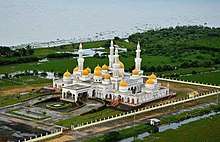Sultan Haji Hassanal Bolkiah Mosque
The Grand Mosque of Cotabato[2][3], officially the Sultan Haji Hassanal Bolkiah Mosque, is situated in Cotabato City and is the largest mosque in the Philippines with the capacity to accommodate 15,000 people.[4] The mosque is located in Barangay Kalanganan II in Cotabato City.[5] It is also the second largest mosque in Southeast Asia after the Istiqlal Mosque of Indonesia.[6]
| Sultan Haji Hassanal Bolkiah Mosque | |
|---|---|
Grand Mosque of Cotabato | |
 | |
| Religion | |
| Affiliation | Islam |
| Location | |
| Location | Cotabato City, Philippines |
| Geographic coordinates | 7.2019°N 124.1656°E |
| Architecture | |
| Architect(s) | Felino Palafox |
| Type | Mosque |
| Funded by | Sultan Hassanal Bolkiah (partial; 53%) |
| Completed | 2011 |
| Construction cost | US$48 million |
| Specifications | |
| Capacity | 15,000 |
| Minaret(s) | 4 |
| Minaret height | 43 m (141 ft)[1] |
Construction
The mosque was erected in 2011[7] with the building's construction reportedly costing US$48 million. Around 53% of the construction cost was partly funded by Sultan Hassanal Bolkiah of Brunei, while the rest was funded by the administration of President Noynoy Aquino. The construction work was done by Manila-based firm New Kanlaon Construction, Inc. with Richard Harris Jordan as project manager. The mosque is 99.12% complete by April 2011. 300 workers were hired for the construction of the mosque.[8]
It was built on a lot donated by Maguindanao First District Representative Didagen Dilangalen.[7]
Architecture and design
The Sultan Haji Hassanal Bolkiah Mosque was designed by local architecture firm Palafox Associates[8] of Felino Palafox.[1] The mosque's domes is painted in gold and their tips are adorned by crescent moons. The building's minarets stands 43 meters (141 ft) high and is lit at night which serves as a guide for aircraft pilots flying near the area.[8] The building itself occupies an area of 5,000 square meters (54,000 sq ft) or half a hectare on a five hectare lot.[8]
Management
The mosque is managed and operated by the Bangsamoro regional government.[9] Prior to this the entity responsible for its management has been disputed, with claims that either the local government of Cotabato City or the defunct Autonomous Region in Muslim Mindanao (ARMM) should manage the religious site. The dispute prompted the national government to temporarily took over the mosque's management except fund allocation for the building's maintenance which has been taken care of by nearby residents. In November 2019, the national government has offered to cede its role of managing the mosque to the Bangsamoro regional government which succeeded the ARMM in the first quarter of the same year as part of the transition process.[7] The mosque was officially turned over to the Bangsamoro regional government on January 8, 2020.[9]
See also
References
- Enriquez, Kenneth (6 April 2019). "Capturing colors of Cotabato". Philippine Daily Inquirer. Retrieved 6 November 2019.
- https://lifestyle.inquirer.net/321555/cotabato-citys-kaleidoscope-houses-grand-mosque-and-bai-walk/
- https://www.pna.gov.ph/articles/1090446
- "A symbol of faith". Philippine Daily Inquirer. Inquirer Research. 2 September 2017. Retrieved 6 November 2019.
- Andong, Lore Mae (30 August 2011). "Muslims flock to Philippines' largest mosque". ABS-CBN News. Retrieved February 7, 2012.
- Indah Gilang Pusparani (May 19, 2018). "Top 7 Largest Mosques in Southeast Asia". Seasia. Cotabato City. Retrieved April 29, 2018.
- Macabalang, Ali (5 November 2019). "BARMM to manage Sultan Bolkiah mosque in Cotabato City". Manila Bulletin. Retrieved 6 November 2019.
- Sarmiento, Bong (3 April 2011). "Brunei-funded grand mosque in Mindanao to open soon". MindaNews. Retrieved 7 November 2019.
- "BARMM takes over Sultan Bolkiah mosque in Cotabato City". Manila Bulletin. 9 January 2020. Retrieved 9 January 2020.
| Wikimedia Commons has media related to Sultan Haji Hassanal Bolkhia Mosque. |
